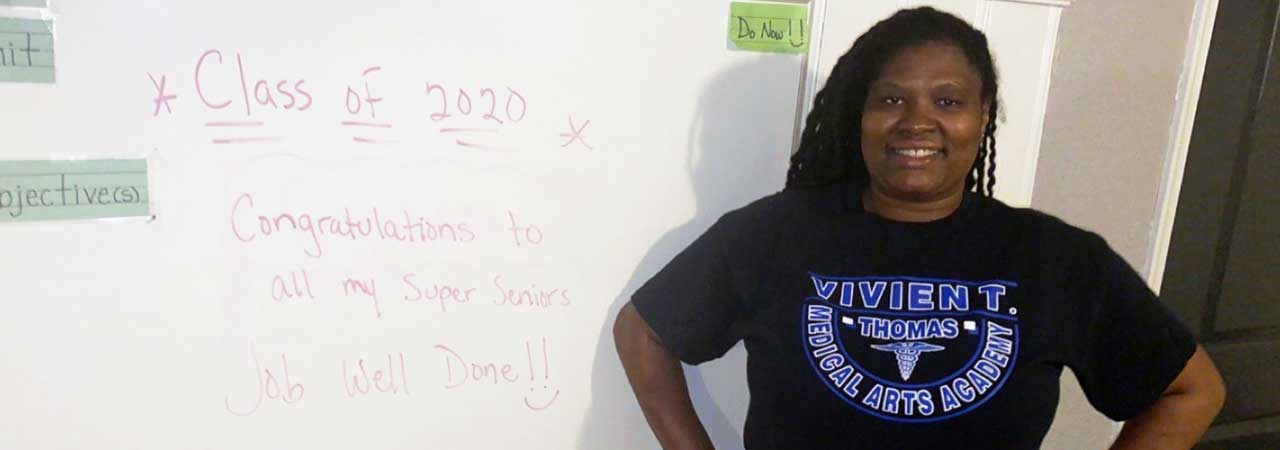Educators adapt to distance learning

“The dog ate my homework.” All educators can probably recall a time in their career when they heard a statement like this from a student.
Now that COVID-19 has prompted educational programs to move out of the classroom and toward distance learning, another phrase is becoming common among students: “I overslept for my video conference call.”
At least this has been the case for students of Yinka Bryant, CDA, dental assisting program director at Vivien T. Thomas Medical Arts Academy in Baltimore, Maryland.
Although most of her students are staying motivated at home, Bryant occasionally has had to address telecommuting tardiness in recent months. “I’ll tell them, ‘You guys are complaining about waking up at 9:15 a.m., when school used to start at 7:50 when we were in session!’” she says with a laugh, adding, “We’re all still getting comfortable with what’s going on right now.”
While Bryant and her students had used a web-based learning tool before COVID-19 became widespread, video conferencing is now taking a prominent role in her lessons for her dental assisting students, who are high school juniors and seniors.
Making technological adaptations
Bryant is not alone in making technological adaptations to traditional classroom learning, following calls for social distancing from government and health officials.
Shannon Stiffler, RDH, M.S., dental assisting instructor at Howard Community College in Columbia, Maryland, and her students have been using an online learning management platform more now that school is held online. They’re learning the technology together as they go, she says.
“Online learning pushes people out of their comfort zone, myself included,” Stiffler elaborates.
Tracy Brasier, CDA, dental health careers instructor at Bucks County Technical High School in Pennsylvania, agrees that with distance learning comes the challenge of identifying which students may be struggling with material. “Unless a student speaks out, I can’t tell,” she shares.
While Brasier’s students already were familiar with online textbooks and other web-based learning tools, they’ve encountered other challenges at home, such as internet connectivity interruptions. “I’m not really sure if that can be helped, though,” Brasier admits. “When the whole world is using the internet at once, that’s going to happen.”
Additionally, Brasier believes her students now have more distractions, as they may be juggling work and home responsibilities along with school tasks.
For Bryant, the transition to online learning has been mostly smooth. “Students are resilient when it comes to technology altogether,” she says. “They know how to use it.”
Turning to the DALE Foundation
Some educators are turning to the DALE Foundation during this unique time of online learning.
To help her students continue their studies and prepare for DANB’s Radiation Health and Safety (RHS) exam and DANB’s Anatomy, Morphology and Physiology (AMP) exam, Brasier has turned to the DALE Foundation. Brasier has purchased the DALE Foundation’s DANB RHS Review course and DANB RHS Practice Test, as well as the DANB AMP Review and DANB AMP Practice Test, for her students. “I thought this would be a great time to incorporate these into my curriculum,” she says. “These subjects can be very overwhelming, with lots of little details that students have to remember.”
By comparing students’ pre- and post-course assessment scores, Brasier believes the DALE Foundation products are making a difference: “Students are spending extra time at home with these materials, and I have seen a huge improvement among the majority of students.”
Bryant’s students also have found success using the DALE Foundation’s DANB RHS Practice Test, which she says helps prepare them to take DANB exams in the future.
“Students’ confidence goes through the roof when they start to answer the practice test questions correctly and understand the information they’ve been taught,” says Bryant. “I love the DALE Foundation’s materials, especially now.”

